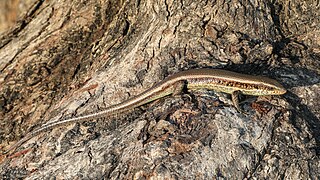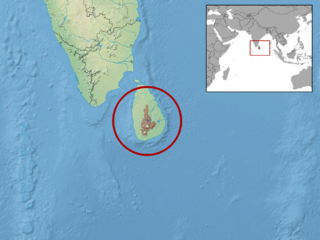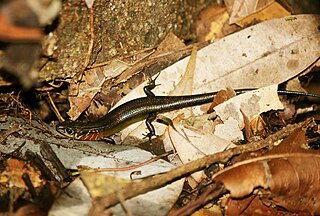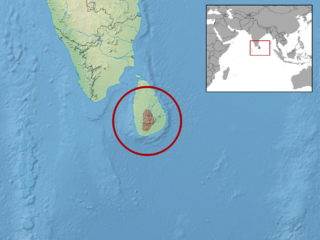Nessia is a genus of skinks, lizards in the family Scincidae. The genus is endemic to Sri Lanka. Species in the genus Nessia are commonly known as snake skinks.
The Haly's tree skink is a species of lizard in the family Scincidae. The species is native to Sri Lanka. Earlier thought to be found also in the Western Ghats, taxonomic studies have shown D. haliana to be a Sri Lankan endemic, differentiated from the Indian D. subcaeruleum. D. haliana is the only arboreal skink in Sri Lanka.

Eutropis bibronii, also known commonly as Bibron's mabuya, Bibron's skink, and the seashore skink, is a species of lizard in the family Scincidae. The species is native to India and Sri Lanka.

The bronze grass skink, bronze mabuya or speckled forest skink, is a species of skink found in South and Southeast Asia. It is a common, but shy, ground-dwelling species that is active both day and night.

Eutropis is a genus of skinks belonging to the subfamily Mabuyinae. For long, this genus was included in the "wastebin taxon" Mabuya; it contains the Asian mabuyas. They often share their habitat with the related common skinks (Sphenomorphus), but they do not compete significantly as their ecological niches differ. This genus also contains the only member of the subfamily to occur in Australasia, the many-lined sun skink, whose wide range includes New Guinea.
Thwaites's skink, also known commonly as the fourtoe snakeskink, is a species of skink, a lizard in the family Scincidae. The species is endemic to the island of Sri Lanka.

Lankascincus deignani, commonly known as Deignan's tree skink and the Deignan tree skink, is a species of lizard in the family Scincidae. The species is endemic to the island of Sri Lanka.

Lankascincus gansi, also commonly known as Gans's lankaskink and Gans's tree skink, is a species of lizard in the family Scincidae. The species is endemic to the island of Sri Lanka.

Lankascincus taprobanensis, also known commonly as the Ceylon tree skink and the smooth Lanka skink, is a species of lizard in the family Scincidae. The species is endemic to the island of Sri Lanka.
Lankascincus taylori, commonly known as Taylor's tree skink, is a species of lizard in the family Scincidae. The species is endemic to the island of Sri Lanka.
Eutropis floweri, also known commonly as Flower's skink, Taylor's skink and Taylor's striped mabuya, is a species of lizard in the family Scincidae. The species is endemic to the island of Sri Lanka.
Eutropis madaraszi, also known commonly as the Sri Lanka bronze mabuya, the Sri Lanka bronze skink, or (ambiguously) the spotted skink, is a species of lizard in the family Scincidae. The species is endemic to the island of Sri Lanka.
Smith's snake skink, also known as the two-legged nessia, is a species of skink endemic to island of Sri Lanka.
Nessia burtonii, commonly known as Burton's nessia, Gray's snake skink, or the three-toed snakeskink, is a species of skink, a lizard in the family Scincidae. The species is endemic to the island of Sri Lanka.
Nessia deraniyagalai, commonly known as Deraniyagala's snake skink, Deraniyagala's snakeskink, or Deraniyagala's nessia, is a species of limbless lizard in the family Scincidae. The species is endemic to the island of Sri Lanka.
Nessia didactyla, also known as the two-toed nessia and two-toed snakeskink, is a species of skink endemic to island of Sri Lanka.
Nessia layardi, commonly known as Layard's snake skink or Layard's nessia, is a species of skink, a lizard in the family Scincidae. The species is endemic to the island of Sri Lanka.
Nessia sarasinorum, commonly known as Sarasins's snake skink or Müller's nessia, is a species of lizard in the family Scincidae. The species is endemic to the island of Sri Lanka.
Nessia gansi, also known commonly as Gans's three-toed snake skink, is a species of lizard in the family Scincidae. The species is endemic to the island of Sri Lanka.





